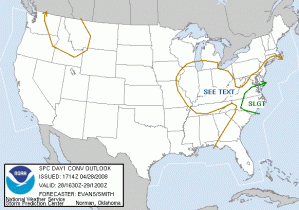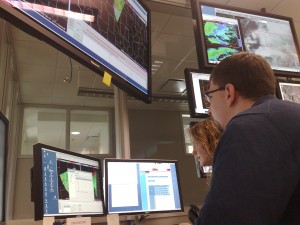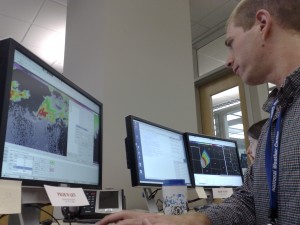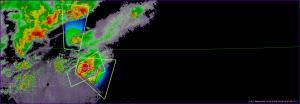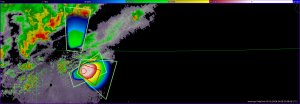Experimental Warning Program Blog Entry: 4/23/08

Between 3 and 5 pm today, Angelyn Kolodziej and I ran through an archived event, using PAR data as the basis for mock severe weather warnings. We both noted the utility of rapid-update radar data in catching the onset of low-level mesocyclogenesis. It was also enlightening to interrogate storms as a team viewing the same data. This forced us to state our reasoning aloud, and resulted in a verbal exchange of conceptual models and warning philosophies. I felt that we arrived at more accurate and timely warning decisions than either one of us could have accomplished alone. When the 1.5 hour simulation concluded, it was fairly obvious from my five plus years of NWS warning experience that we had issued more warnings over a small area than we would have issued using WSR-88D data. Angelyn and I suspect the PAR scan strategy captured certain features that tipped the scales toward issuing a warning, and which may have fallen between traditional WSR-88D volume scans.
Shortly after 5 pm, we had intended to begin probabilistic warning operations, but paused to observe the supercell that came up to the south and east of Norman. All eyes were fixed on the live updating PAR data and the SADS. Oklahoma City television crews delivered video of a low hanging wall cloud with rising scud, but weak rotation. The circulation never quite tightened up, and the storm had trouble maintaining supercell structure for any length of time.
The Norman storm was at the southeast extend of an extensive cluster of multicell thunderstorms that spread northward across Oklahoma through mid evening. Between 6 and 8pm, Mike Magsig worked this activity from one of the probabilistic warning desks. Meanwhile, at the second desk, I shifted my attention to an ongoing high-end severe weather event in north Texas. A long-lived, high-precipitation supercell moved eastward into the Fort Worth WSR-88D domain. This storm expanded in size, forming a classic bow echo anchored by a broad mesocyclone at the northern end. An exceptionally intense rear inflow jet presented 90 to 100 knot ground-relative velocities at times. Out ahead of this complex, another large supercell formed and approached the southern sides of Fort Worth. This storm quickly took on the appearance of a classic, tornadic supercell. Eventually, the bow echo overtook the tornadic storm in the vicinity of the KFWS radar. With the advantage of near range sampling at low levels, the radar detected several small-scale vortices along the leading edge of the storm outflow.
The variety of storm modes and storm motions in the two operational domains fostered a productive discussion between myself, Mike, and Greg Stumpf. Mike had difficulty drawing probabilistic grids for the transient multicell hail storms taking place in Oklahoma. One potential approach may be to outline a broad area of low probability severe hail, and then embed shorter duration, higher probability warnings for particular cores that show some persistence or organization. Whatever the warning philosophy, the actual grid preparation could benefit from some type of automated routine or suite of routines for defining a threat area. For instance, a tool that outlines the 55 dbZ contour with attention to echo overhang might be a good starting point for drawing a hail threat area.
The Texas storms brought up a host of even more complex issues, including personal tornado warning thresholds expressed as a percent chance of tornado, detailed spatial resolution of tornado threats (e.g. high probability surrounding a TVS and lower probabilities along the RFD gust front), and how to emulate longer lead-time information in a probabilistic way (e.g. drawing a 2-hour probability swath to mimic a special weather statement that WFO Fort Worth issued to raise awareness in the metropolitan area).
Much of our conversation stemmed from large scale design issues, using examples from the evening’s data to explore probabilistic warning strategies. In general, we concluded that in designing a probabilistic warning system, researchers may begin with an idealized philosophy, and then incorporate forecaster preferences that have been gained through experience. Many of these preferences will hopefully become evident throughout the course of the EWP spring activities.
Patrick Burke (WFO OUN Forecaster, EWP Weekly Coordinator-in-Training)

